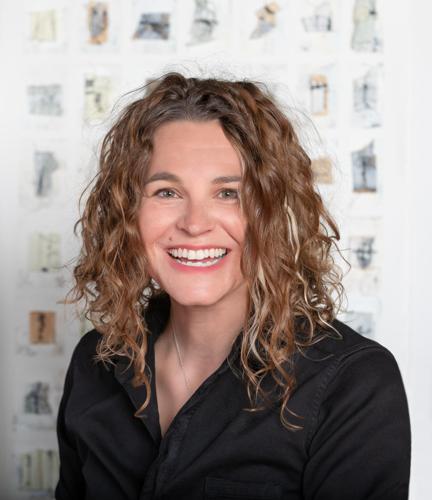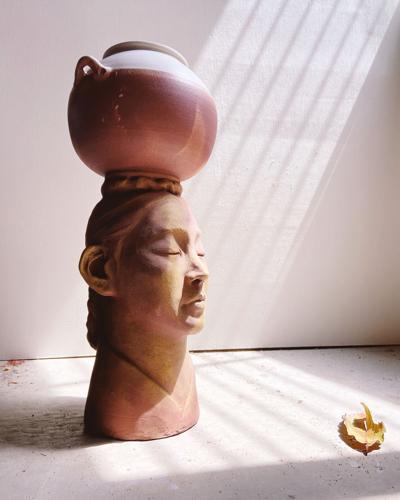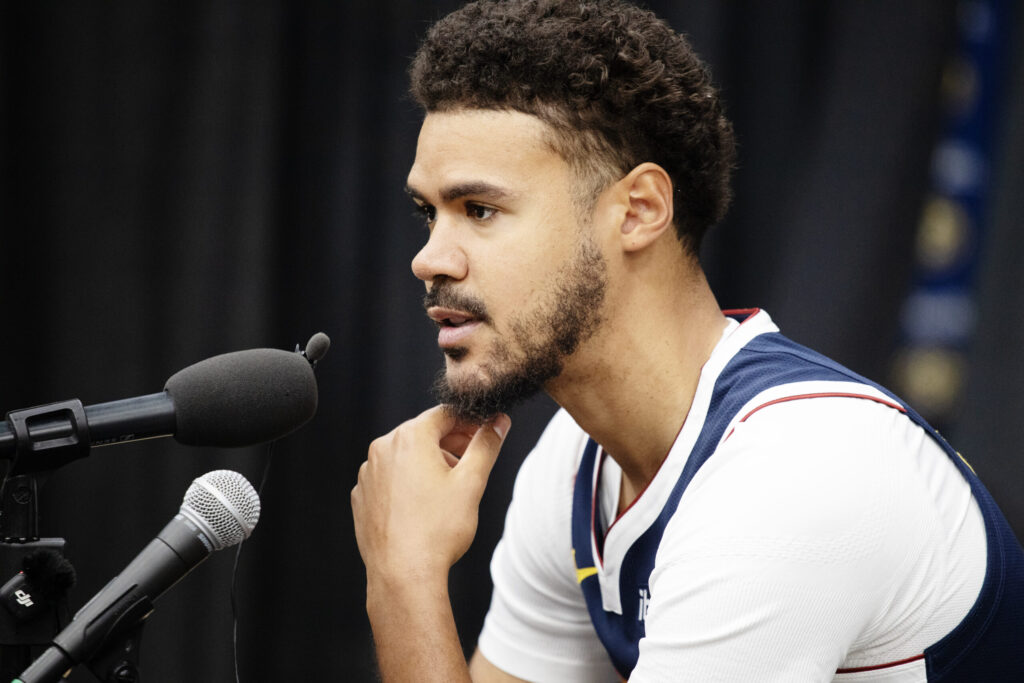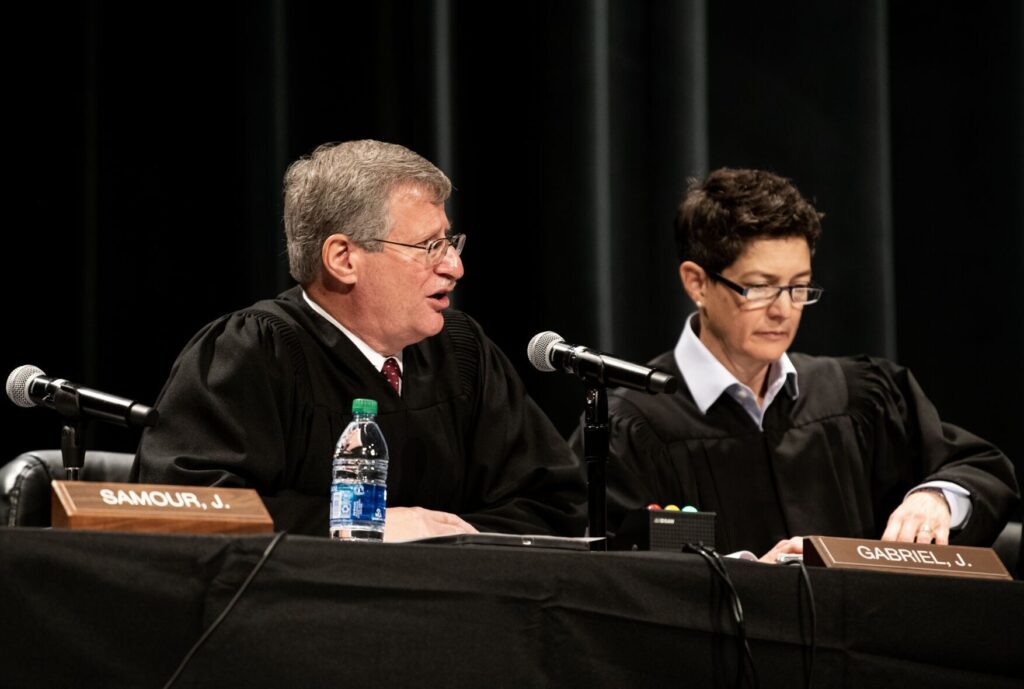Annual July 4th fest cherry-picks arts
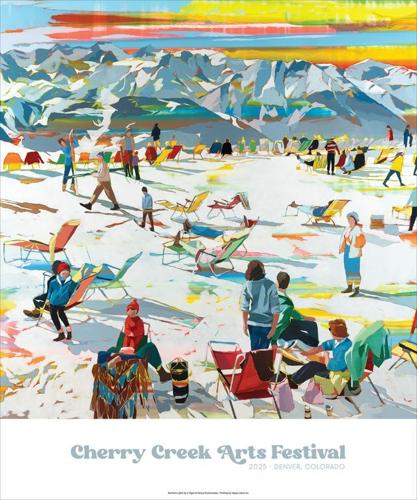
This year’s collectible poster, titled “Northern Lights,” is by husband and wife Signe and Genna Grushovenko. The Grushovenkos collaborate on contemporary oil paintings inspired by vintage photography. They have exhibited at the festival for years and drew inspiration for the poster from a mid-century photo of a “ski beach.”
Courtesy, Cherry Creek Arts Festival
For the 34th year, on three consecutive days including the 4th of July, throngs of people will flock to the Cherry Creek Arts Festival. It’s a cool event staged during a typically hot stretch of summer.
Despite often incendiary heat, crowds — last year more than 150,000 — turn up for the live music, street food, people-watching, fireworks and, of course, the art.
This year, from Friday through Sunday, 260 artists selected from 2,085 applicants will showcase art in 13 media: ceramics, digital art, drawing, fiber, glass, jewelry, metalworks, mixed media, painting, photography, printmaking, sculpture and wood.
Artists for the Cherry Creek Arts Festival are cherry-picked by a jury, and the 2025 roster includes artists from six countries outside of the U.S. This year, 36 Coloradans made the cut.
An oil painter, Michael Magrin will exhibit for his fourth year in the show. From plein air settings near his home in Parker, Magrin paints Colorado landscapes focused on dramatic skies and long views of the Front Range of the Rocky Mountains.
Cherry Creek hosts a best arts fest
“Cherry Creek is truly one of the top art festivals in the country. It draws some of the best visual artists from across the nation, and it’s an honor to be part of that caliber of talent,” Magrin said. “The quality of the work on display, paired with the energy of the 4th of July weekend brings in a large and engaged audience. There’s a vibrancy to this show that sets it apart.”
Magrin teaches drawing and painting to sixth- through eighth-graders at Campus Middle School in Greenwood Village. Like many artists exhibiting in the event, he donates one of his artworks to the auction that raises funds for year-round arts education in Colorado.
Festival funds arts education in Colorado
“As a teacher myself, I deeply support the mission of CherryArts,” Magrin said. “They provide meaningful access to the arts for over 40,000 students across Colorado. I love that CherryArts invests in young minds by making art accessible and engaging. Their programs — like the Mobile Art Gallery, Student Art Buying Program, and Mobile Art Cart — are reaching tens of thousands of students with hands-on experiences. As an educator, I appreciate their belief that access to the arts should be for everyone, and that artists are essential to a thriving society.”
Magrin said the festival has been lucrative for him: “This is typically my biggest event of the year in terms of sales volume,” he said. “Seasoned collectors often make purchases early on the first day, knowing that the pieces they’re drawn to may not be available later in the weekend. I’ve been fortunate to have sold out completely for two years. It’s also a great opportunity to connect with new collectors and line up commissions for clients who want something custom for their home or space.”
CherryArts reported that last year’s sales averaged $20,629 per artist, with more than $4.6 million in total sales.
From midwife to mixed-media artist
One of 64 first-time exhibitors, Julia Martin of Denver had set her sights on the Cherry Creek Arts Festival.
“This was my big goal,” said Martin. “This is my first big festival, and art festivals are so important because they allow for one-on-one interaction between artists and art appreciators. In festivals, we see and feel in the air how much art is going on underneath the surface.”
Martin, who lives in the Central Park neighborhood, emphasized the event’s scale and scope.
“We’re so lucky to have this art festival in our backyard. Cherry Creek Arts Festival is international, and not a huge proportion of artists are local. The show is not homogenous,” she said. “This is a large cultural phenomenon that raises awareness about creative risk-taking current trends so people can see something happening on the ground.”
Martin’s creative risk-taking results in mixed-media assemblages incorporating her handwritten paper notes, fabric, thread, oil paints and cold wax, often arranged in a grid.
Martin is largely self-taught, but learned some needle skill from her great-grandmother, grandmother and mother. Educated in psychology and trained at Yale University as a midwife, the stitches Martin often administered in her career as a midwife worked their way into her art.
“I always loved to sew, but I am an unruly sewer,” Martin said. “I like when the thread does what it wants to do. I basically draw with thread.”
Compassion in her palette
Martin creates works in her “Pocket Notes” series around scraps of paper upon which she jots musings, then carries in her pocket to weather. For Martin, compassion is part of her artist’s palette, and her works are both revealing and mysterious.
“The notes get sewn up, and some words are seen and some obscured to convey the feeling that we are all carrying with us that which can’t be seen,” Martin said. “All people need tenderness for the things that are sacred and private. Not everything needs to be shared, and we can give each other grace as we are trying to figure out things.”
Like most artists, Martin intends for her pieces to evoke emotion.
“I think that is what makes art relevant, what makes art powerful and what makes people need art so much,” said Martin. “I feel beholden to respond to the times we live in, and there are a lot of different ways to do that, from expressing something very specific to the collective feelings going on in the ether.”
Martin’s work presents imperfections as beauty and a reflection of the human condition.
“I love messy edges. I love scraps and found objects others have discarded,” she said. “When I’ve gone to the Cherry Creek Arts Festival, many things are so excellent and so polished. My art has messy edges. It’s raw, and I am trying to say that messiness is part of beauty.”
Martin’s assemblages invite viewers to look more closely.
Art captures human feelings
“I want the work, the small pieces on a larger grid, to say something to the person standing back, so they have to get close to it. That is purposeful. I think when we hold people or feelings at arm’s length, we can’t move through them. We get stuck,” Martin said.
“When you get close, it is not perfect, and to see that is to be human. That is how we grow and change,” she said. “I want people to see the artists’ hand in the work, the imperfections.”
Emerging artist wins CherryArts grant
Another Coloradan, Kang Eunjoo, won one of five CherryArts Emerging Artist Grants consisting of $5,000 in unrestricted funds, a mentor program and a booth at the festival.
Kang came to the U.S. from South Korea in 2020 to study English with a plan to become a museum curator. She fell in love with Colorado and her mate.
“My partner and I have always been drawn to mountains and nature, so when we arrived in Denver, it was love at first sight. That feeling still hasn’t changed,” she said. “Korea also has major mountain ranges, but Korean mountains tend to feel rounder and softer. In contrast, the Rocky Mountains in Colorado are more dramatic, making me feel the awe of how small humans are in the vastness of nature. What inspired me even more here is the attention people give to wildlife and their efforts to protect those natural spaces.”
The Cherry Creek Arts Festival is her biggest art show so far.
“I’m really excited about the chance to meet so many people who love and work in the arts,” she said. “Since I moved from Korea and have not had many chances to connect with the wider art community in Denver, this feels like a great opportunity.”
Ceramics’ unpredictability mirrors life
“I once heard someone say that a ceramic artist’s day moves differently, and I agree. Like a life cycle, the ceramic process is long, difficult and demanding but incredibly rewarding. You never fully know the result until it comes out of the kiln. Even after months of effort, a piece can crack, warp, or come out with unexpected colors,” Kang said. “That uncertainty makes ceramics experimental and demanding and yet, that is exactly why I love it. Its imperfection reflects human life,” she said. “Sometimes unexpected variables arise but those surprises can become the most beautiful and unique aspects of the work.”
Colorado nature inspires ceramist
“I stay inspired by spending time in nature. I go to the mountains or the river and breathe in the scent of pine. I observe the shapes of rocks closely. Nature always offers something new to discover,” Kang said.
“I hope to share quiet peaceful moments and small smiles from everyday life,” she added. “With so much noise and hardship happening in the world today people can feel overwhelmed. I believe fine art offers a space for independent thought. Each artwork is different and carries its own message. That can prompt someone to pause and ask themselves what they truly think or feel. It can help people reconnect with themselves even for a brief moment, and that is something deeply valuable.”







